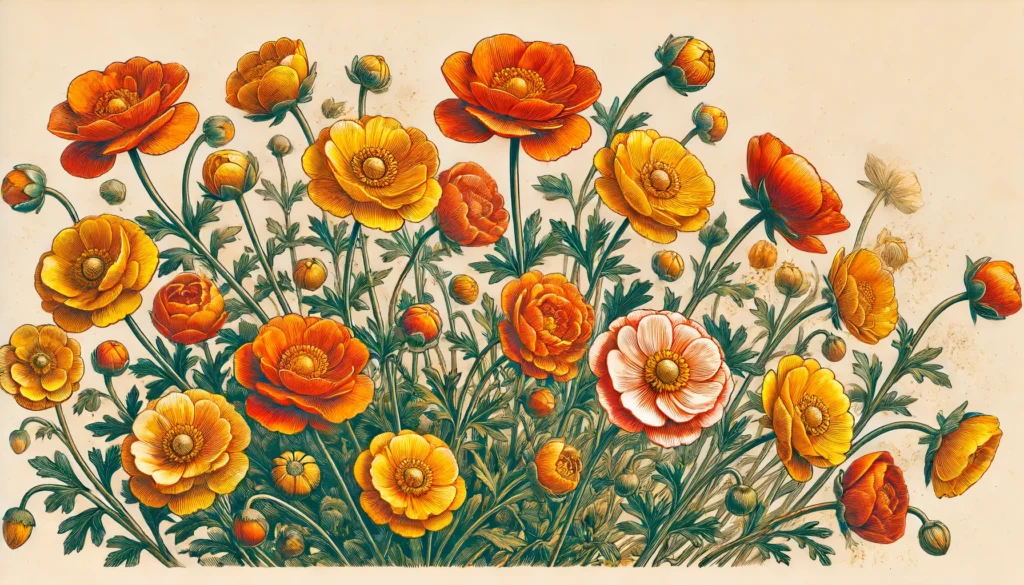

Home » Cat Plants » How Dangerous is the Buttercup Plant for Cats?

The Buttercup (Ranunculus spp.) is a toxic plant for cats. It contains protoanemonin, a toxin that can cause moderate to severe poisoning. This compound primarily affects the gastrointestinal system and can lead to oral irritation. Buttercups are commonly found in fields, gardens, and natural areas across many regions.
Ingestion may cause mild gastrointestinal upset, but is generally not life-threatening.
Ingestion can result in mild symptoms like vomiting, diarrhea, or drooling. Rarely fatal but may require veterinary care.
Eating these plants can lead to more pronounced symptoms like abdominal pain, lethargy, or difficulty breathing. Veterinary intervention may be necessary.
Ingesting even small amounts can cause severe symptoms like organ damage, seizures, or cardiac failure without rapid treatment.
All parts of these plants are extremely poisonous to cats and can quickly lead to death, even with immediate veterinary care.
** Please note: Please note that toxicity level can vary based on the amount ingested and the specific cat. It's always best to keep these plants completely inaccessible to cats and seek immediate veterinary care or call the poison hotline if you suspect your cat has ingested any part of a toxic plant.
If a cat ingests the Buttercup, it may experience various symptoms related to gastrointestinal distress. Common signs include vomiting, diarrhea, abdominal pain, excessive drooling (hypersalivation), oral ulcers, depression, anorexia (loss of appetite), wobbly gait, and weakness. The severity of symptoms depends on the amount of plant material consumed.
If you suspect your cat has ingested the Buttercup, it is crucial to seek veterinary attention immediately. The veterinarian will likely perform a physical examination, obtain a detailed history of the incident, and potentially conduct blood tests and urinalysis. Based on the findings and your cat’s symptoms, they may diagnose plant poisoning or toxicity caused by the Buttercup. The veterinarian may also rule out other potential causes, such as gastrointestinal disorders or infections. For more information, you can refer to this

A: Yes, cats can be allergic to Buttercup. Symptoms of an allergic reaction may include itching, sneezing, and skin irritation.
A: Yes, Buttercup is toxic to cats. Ingesting any part of this plant can cause symptoms such as vomiting, diarrhea, and drooling.
A: Symptoms of Buttercup poisoning in cats include vomiting, diarrhea, excessive drooling, abdominal pain, and difficulty breathing. Immediate veterinary care is recommended if ingestion is suspected.
A: To prevent contact, ensure that Buttercup is not present in your home or garden. Keep your cat indoors or monitor outdoor activities closely to avoid exposure.
A: If your cat ingests Buttercup, contact your veterinarian immediately. Do not induce vomiting unless instructed by a veterinary professional. Immediate medical attention is necessary.
A: Yes, Buttercup is commonly found in gardens and wild areas. It is important to ensure this plant is kept out of reach of cats to prevent accidental ingestion.
The Buttercup (Ranunculus) is a genus of flowering plants belonging to the Ranunculaceae family. These plants have been around for millions of years, with fossil records dating back to the Paleocene epoch (around 66 million years ago). Buttercups are native to various regions, including Europe, Asia, and North America. They were historically used for medicinal purposes, such as treating skin conditions and respiratory ailments, but their toxic properties were also recognized.
Please note: The information shared in this post is for informational purposes only and should not be considered as veterinary medical advice.
🐾 A hilarious or heart-melting cat video
🐾 Our latest paws-on review of a cool cat toy